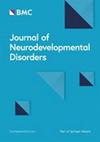Differential cognitive and behavioral development from 6 to 24 months in autism and fragile X syndrome
IF 4
2区 医学
Q1 CLINICAL NEUROLOGY
引用次数: 0
Abstract
Specifying early developmental differences among neurodevelopmental disorders with distinct etiologies is critical to improving early identification and tailored intervention during the first years of life. Recent studies have uncovered important differences between infants with fragile X syndrome (FXS) and infants with familial history of autism spectrum disorder who go on to develop autism themselves (FH-ASD), including differences in brain development and behavior. Thus far, there have been no studies longitudinally investigating differential developmental skill profiles in FXS and FH-ASD infants. The current study contrasted longitudinal trajectories of verbal (expressive and receptive language) and nonverbal (gross and fine motor, visual reception) skills in FXS and FH-ASD infants, compared to FH infants who did not develop ASD (FH-nonASD) and typically developing controls. Infants with FXS showed delays on a nonverbal composite compared to FH-ASD (as well as FH-nonASD and control) infants as early as 6 months of age. By 12 months an ordinal pattern of scores was established between groups on all domains tested, such that controls > FH-nonASD > FH-ASD > FXS. This pattern persisted through 24 months. Cognitive level differentially influenced developmental trajectories for FXS and FH-ASD. Our results demonstrate detectable group differences by 6 months between FXS and FH-ASD as well as differential trajectories on each domain throughout infancy. This work further highlights an earlier onset of global cognitive delays in FXS and, conversely, a protracted period of more slowly emerging delays in FH-ASD. Divergent neural and cognitive development in infancy between FXS and FH-ASD contributes to our understanding of important distinctions in the development and behavioral phenotype of these two groups.自闭症和脆性 X 综合征在 6 到 24 个月期间的认知和行为发展差异
明确不同病因的神经发育障碍之间的早期发育差异,对于改善生命最初几年的早期识别和有针对性的干预至关重要。最近的研究发现,脆性 X 综合征(FXS)婴儿与有自闭症谱系障碍家族史并最终发展为自闭症(FH-ASD)的婴儿之间存在重要差异,包括大脑发育和行为方面的差异。迄今为止,还没有研究对 FXS 婴儿和 FH-ASD 婴儿的不同发育技能特征进行纵向调查。本研究对比了 FXS 婴儿和 FH-ASD 婴儿与未患 ASD 的 FH 婴儿(FH-nonASD)和发育正常的对照组婴儿在言语(表达性语言和接受性语言)和非言语(粗大运动和精细运动、视觉接收)技能方面的纵向轨迹。与患有 FH-ASD 的婴儿(以及患有 FH-nonASD 的婴儿和对照组婴儿)相比,患有 FXS 的婴儿早在 6 个月大时就在非语言综合能力方面出现了延迟。到 12 个月大时,各组之间在所有测试领域的得分已形成一个顺序模式,即对照组 > FH-nonASD > FH-ASD > FXS。这种模式一直持续到 24 个月。认知水平对 FXS 和 FH-ASD 的发育轨迹有着不同的影响。我们的研究结果表明,在 6 个月大时,FXS 和 FH-ASD 之间存在可察觉的群体差异,而且在整个婴儿期,每个领域的发展轨迹也不尽相同。这项研究还进一步凸显了 FXS 患儿较早出现的全面认知延迟,而 FH-ASD 患儿则长期存在较缓慢的认知延迟。FXS和FH-ASD在婴儿期的神经和认知发展存在差异,这有助于我们了解这两个群体在发展和行为表型上的重要区别。
本文章由计算机程序翻译,如有差异,请以英文原文为准。
求助全文
约1分钟内获得全文
求助全文
来源期刊
CiteScore
7.60
自引率
4.10%
发文量
58
审稿时长
>12 weeks
期刊介绍:
Journal of Neurodevelopmental Disorders is an open access journal that integrates current, cutting-edge research across a number of disciplines, including neurobiology, genetics, cognitive neuroscience, psychiatry and psychology. The journal’s primary focus is on the pathogenesis of neurodevelopmental disorders including autism, fragile X syndrome, tuberous sclerosis, Turner Syndrome, 22q Deletion Syndrome, Prader-Willi and Angelman Syndrome, Williams syndrome, lysosomal storage diseases, dyslexia, specific language impairment and fetal alcohol syndrome. With the discovery of specific genes underlying neurodevelopmental syndromes, the emergence of powerful tools for studying neural circuitry, and the development of new approaches for exploring molecular mechanisms, interdisciplinary research on the pathogenesis of neurodevelopmental disorders is now increasingly common. Journal of Neurodevelopmental Disorders provides a unique venue for researchers interested in comparing and contrasting mechanisms and characteristics related to the pathogenesis of the full range of neurodevelopmental disorders, sharpening our understanding of the etiology and relevant phenotypes of each condition.

 求助内容:
求助内容: 应助结果提醒方式:
应助结果提醒方式:


